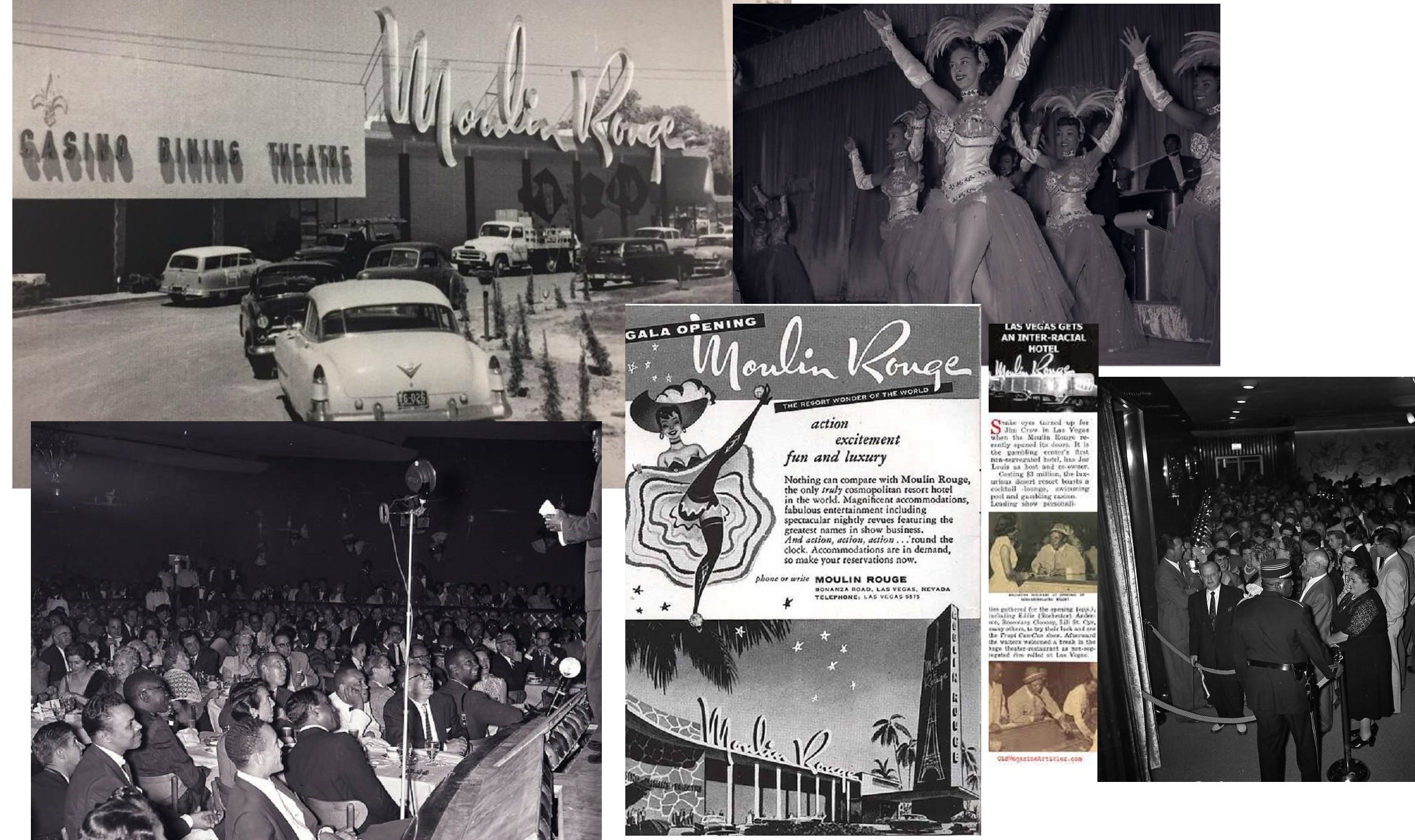Final Tune: The Suspicious Death of a Jazz Musician in 50's Vegas
Jazz musician Wardell Gray died under suspicious circumstances on the opening night of the Moulin Rouge Hotel in Las Vegas. Some speculate Gray’s death was due to an accident while others theorize he was murdered. (Las Vegas-Clark County Library District/UCR - California Digital Newspaper Collection/Wardellgray.com)
a jazz man’s last act
Wardell Gray was a sax player that specialized in the bebop style of jazz during the 1940’s. Gray rose quickly in the jazz world, and he played with the likes of Benny Goodman and the Count Basie Orchestra.
But Gray’s music career would be cut short on a night in Las Vegas in 1955 when the musician’s body was found in the desert under mysterious circumstances.
The Moulin Rouge was the first integrated hotel and casino in Las Vegas, with its opening garnering national attention. (UNLV Digital Collection)
progress in the Mississippi of the west
Las Vegas has an ugly history of segregation that followed a few decades of relaxed racial attitudes during the first decades after the city’s founding. With the establishment of legalized gaming in 1931, the city’s casinos began to attract plenty of tourists from Texas and the South. And by the 1940’s the bigoted attitudes of the mob-connected owners of the Strip and downtown casinos worked to create a de facto system of racial segregation in Las Vegas.
A 1954 issue of Ebony magazine dubbed Las Vegas the “Mississippi of the West” due to the blatant code of racial segregation implemented in the city. Black entertainers that performed in the showrooms of the Strip hotels were barred from staying at those same venues.
Amidst this backdrop, investors seeking to develop a more inclusive Las Vegas built the Moulin Rouge Hotel. Located on the city’s Westside on Bonanza Road, the Moulin Rouge was billed as the first integrated hotel-casino in Vegas.
In typical Las Vegas fashion, the owners of the Moulin Rouge wanted the opening day for the establishment to be an event to remember. In addition to having world-famous heavyweight boxing champ Joe Louis serving as a greeter, the Moulin Rouge would also feature performances by jazz artist Benny Carter and his backup band that included Wardell Gray on saxophone.
Gray traveled to Vegas from Los Angeles on a Monday and attended rehearsals with Carter’s band over the next two days. But Gray was not present on the stage for the opening night of the Moulin Rouge on May 25, 1955.
Wardell Gray made his mark as a talented saxophonist, playing with the likes of Benny Goodman and the Count Basie Orchestra. (Wardellgray.com/Las Vegas-Clark County Library District)
bebop sensation
Wardell Gray was only 34-years-old when he made the trek to southern Nevada to help herald the opening of the Moulin Rouge and a step toward an integrated Vegas.
After catching the attention of some of the biggest names in jazz during the 30’s and 40’s, Gray’s career had fallen off starting in the early 50’s, with this decline rumored to be due in part to the young musician dabbling with heroin. However, there were close associates of Gray that swore he never touched narcotics and cited as proof his ability to maintain the high level of acumen needed to play for years with Benny Goodman and Count Basie.
Despite the recent slump, Gray seemed to be his old self during the practices with Carter’s band leading up to the grand opening. And Gray’s home life with his wife and daughter was reportedly happy as well. In fact, Gray had stopped touring with Count Basie in order to spend less time on the road and more with his family in Los Angeles.
Contemporary news coverage of Wardell Gray’s suspicious death in 1955. Gray’s body was located on the Boulderado Ranch, also known as Kiel Ranch. (UNLV Digital Collection/UCR - California Digital Newspaper Collection)
death in the desert
Wardell Gray inexplicably failed to show up for his performance on the Moulin Rouge’s opening night. Someone was dispatched to Gray’s hotel room, but there was no trace of the musician in his quarters.
The mystery of Gray’s whereabout would be solved soon enough when his body was discovered in the desert outside the city on May 26, 1955.
James Losee, the operator of the Boulderado Ranch near W. College Boulevard and the railroad tracks, contacted the police after discovering Gray’s body in a drainage ditch on his property. Gray was still dressed in a dark blue suit, dress shirt, and tie. Curiously, the body bore no signs of trauma aside from a scratch above Gray’s left eyebrow. An autopsy later demonstrated that Gray had died of a broken neck and a fractured skull that appeared to have been caused by a “blunt object.”
The death of Wardell Gray stole some of the local press attention from the grand opening of the Moulin Rouge. An article in the Las Vegas Review-Journal from shortly after Gray’s death noted questions surrounding the musician’s demise. (Las Vegas-Clark County Library District)
an accidental death?
Detectives with the Las Vegas Police Department interviewed those that were last with Gray in an effort to reconstruct the events leading up to his death. Police learned that one of the last people Gray was seen alive with was Theodore Homer Haley, a dancer at the Moulin Rouge.
Officers found an intoxicated Haley when they went to interview the dancer at his Westside apartment. Haley was arrested and taken in for questioning, but he denied any involvement in Gray’s death.
A break in the investigation occurred a few hours later when a friend of Haley went to the police and informed them that he had lent Haley his car the prior morning. Police searched the vehicle and found blood spots.
Upon being confronted with the details provided by his friend, Haley changed his story and admitted he ran into Gray at about 12:30 a.m. in the lobby of the Moulin Rouge. The two struck up a conversation and Haley invited Gray to a “dope party” at his apartment. At some point during the party, Gray and Haley sat on a bed while shooting up heroin.
Haley told police that when he came to, he saw Gray sprawled out on the floor with a small cut above his eye. He thought Gray was unconscious, so he wet a towel and placed it under the musician’s head. Then Haley left the apartment and walked around downtown Vegas. Haley’s common law wife, who was employed as a sex worker, came to the apartment with a client at around 8:00 a.m. and discovered Gray’s body.
This triggered the series of events leading to Haley asking to borrow a friend’s car so he could transport Gray’s body into the desert in an effort to avoid police questioning for narcotics use. Haley placed Gray’s body in the backseat of the car and drove into the desert until he found a sufficiently deserted spot. Then Haley dragged the body about nine feet away from the road and threw it into a ditch.
The Moulin Rouge was a popular draw for locals and celebrities alike, but the establishment closed after only about six months. The structure eventually succumbed to several fires over the years and was demolished. Some speculate Gray was murdered in a dispute over a gambling debt or that he was the victim of a racially motivated murder. Though the Moulin Rouge was a step toward equality, white supremacist attitudes were still a potent force in 1950’s Las Vegas. (Las Vegas-Clark County Library District/UNLV Digital Collection)
Open Questions and the end of the Moulin Rouge
Investigators put Haley through a lie detector exam and determined that he did not strike Gray during what the local press called a “heroin spree.” Police signed onto Haley’s version of the events leading to Wardell Gray’s death at the age of thirty-four. Haley was charged for removing Gray’s body from the Moulin Rouge and received a ninety day sentence in the Clark County Jail.
Some of Gray’s associates questioned the official story. For one, many found it impossible for Gray to suffer a broken neck and fractured skull from an eighteen-inch fall from a bed to the floor. Among the theories that have been put forward were that Gray was murdered over an unpaid gambling debt, a belief bolstered by the organized crime element percolating just beneath the surface across the city. Others speculated that Gray may have been targeted by local white supremacists angered over the opening of the Moulin Rouge or for other racially motivated reasons.
The official death certificate for Gray indicates “Fall on cement floor” in response to “How did injury occur?” And some interviewed about Gray’s death thought the additional injuries to his spine may have been caused by the force of being dropped in the desert.
As for the Moulin Rouge, the attraction to the new establishment was immediate. Celebrities flocked to the casino floor and Life magazine featured the Moulin Rouge on its cover. Despite this success, the first integrated hotel in Las Vegas would shut down after only about six months of operation.
Efforts to revitalize the Moulin Rouge have failed to take off, and a series of fires in the early 2000’s gutted the structure. Today only a vacant lot and sign frame remain where the Moulin Rouge once stood as a symbol of a more inclusive Las Vegas.
Sources:
https://jazz24.wordpress.com/2010/11/28/the-mysterious-death-of-a-tenor-man-wardell-gray-and-the-moulin-rouge/
http://wardellgray.org/






